
Animals may not be the first thing that comes to mind when you hear “Sweden.”
Maybe you think about the delicious Swedish meatballs you had that one time. Or maybe the sailing enthusiasts you’ve seen on Instagram. While this Nordic country is known for those things and more, what it’s not given enough credit for is its stunning diversity of wildlife.
Learning animal names in Swedish will help you describe and talk about the huge number of wild creatures that call Sweden home. Moose, beavers, wolves, brown bears, arctic foxes, wolverines, lynxes, wild boars, otters…and the list goes on. There are even tours dedicated to finding specific animals (like lynxes) in the wilderness. As such, learning the names of animals in Swedish will be essential if you like to travel or consider yourself a serious animal lover.
In this article, we’ve compiled several vocabulary lists for different kinds of animals and broken them down by category for you.
Without further ado, let’s dig right in…
 Table of Contents
Table of Contents
- At Home (Pets)
- On the Farm (Farm Animals)
- In the Wild / Forest / Safari (Land Animals)
- Bugs and Insects
- In the Ocean (Aquatic / Marine Animals)
- Reptiles & Amphibians
- Birds
- Animal Body Parts
- Animal-Related Idioms and Slang Expressions
- Conclusion
1. At Home (Pets)

Swedes treat their pets like family. The sense of equality that’s dominant in Sweden also covers animals; they’re considered so much more than just a creature that needs to be fed. To give you an idea, many Swedes even work their schedule around their pets’ needs!
More and more Swedish companies are allowing their employees to bring their pets to work, and pets (especially dogs) go with their owners on vacation. Dog owners in Sweden always seem to be walking their dogs, and there’s plenty of space for them to enjoy thanks to the country’s abundance of nature.
Swedes take pride in owning their dogs, and it’s considered strange to have one’s dog left out to play around or do “normal” activities. You’re expected to have your dog participate in events and competitions, and to make it a member of a dog association or club.
In other words, dogs are the 24/7 companions of Swedes.
While dogs are Swedes’ personal favorite pet, other animals are not so uncommon. Below is a list of nine housepets you may stumble upon in Sweden:
| Katt | “Cat” |
| Hund | “Dog” |
| Hamster | “Hamster” |
| Kanin | “Rabbit” |
| Mus | “Mouse” |
| Råtta | “Rat” |
| Marsvin | “Guinea pig” |
| Guldfisk | “Goldfish” |
| Papegoja | “Parrot” |
2. On the Farm (Farm Animals)

Agriculture in Sweden is not evenly distributed among the country’s regions. This is because it makes more sense to use the mountainous parts for forestry rather than farming activities. The farther south you go, the more agricultural land you’ll find. Still, not that many plant types can be grown here, given the limitations imposed by the weather and short growing seasons.
Only 1.5% of Sweden’s working population is involved in agriculture. Traditional farming is not very common in the country, though urban farming is on the rise as people are becoming more environmentally aware. Many Swedes now prefer to grow their own produce, be it in their apartment or their home garden in the suburbs.
Below is a list of farm animals in Swedish along with their English translations:
| Ko | “Cow” |
| Gris | “Pig” |
| Får | “Sheep” |
| Get | “Goat” |
| Häst | “Horse” |
| Höna | “Hen” |
| Kalkon | “Turkey” |
| Gås | “Goose” |
| Anka | “Duck” |
| Tupp | “Rooster” |
Hungry for even more vocabulary? Then head over to our lesson on farm animals in Sweden to learn the names of even more animals!
3. In the Wild / Forest / Safari (Land Animals)

Sweden is home to several predators, including bears, lynxes, wolves, and wolverines. Sweden is one of the largest European countries, yet it has the second-lowest population density. This gives the country tons of free space for animals to roam far away from humans.
You can experience Swedish wildlife anywhere, from private or public forests to national parks. Still, a big misconception about Sweden is that predators roam the streets. The truth is that large predators are rarely seen out and about unless you go out for the sole purpose of finding them in certain areas.
Given the low attack rates, experts describe Swedish nature as perfect for those looking to experience wildlife and camping without facing serious predator danger. The only danger lurking in the forests of Sweden is not large animals, but rather what we’ll cover in the next section.
But first, here’s a comprehensive list of wild animals in Swedish:
| Björn | “Bear” |
| Varg | “Wolf” |
| Rådjur | “Deer” |
| Hare | “Hare” |
| Räv | “Fox” |
| Igelkott | “Hedgehog” |
| Ekorre | “Squirrel” |
| Vildsvin | “Boar” |
| Groundhog | “Groundhog” |
| Lejon | “Lion” |
| Tiger | “Tiger” |
| Jaguar | “Jaguar” |
| Panter | “Panther” |
| Elefant | “Elephant” |
| Giraff | “Giraffe” |
| Apa | “Monkey” |
| Gorilla | “Gorilla” |
| Känguru | “Kangaroo” |
| Koala | “Koala” |
| Panda | “Panda” |
| Sengångare | “Sloth” |
| Säl | “Seal” |
| Pingvin | “Penguin” |
| Isbjörn | “Polar bear” |
| Valross | “Walrus” |
Enthralled by wild animals? Then you’ll love our lesson on forest animal vocabulary!
4. Bugs and Insects
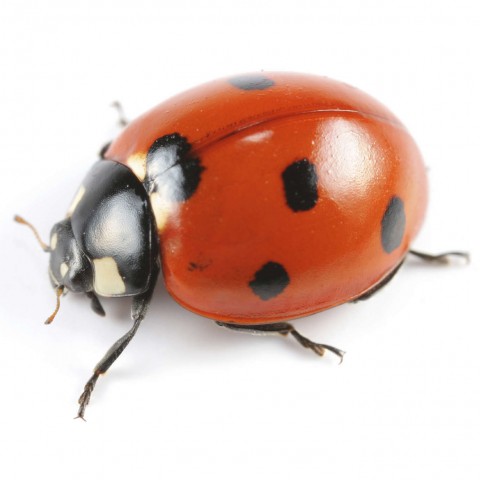
I don’t mean to scare you off, but wasps are the #1 cause of death inflicted by animals in Sweden.
Surprising, right?
Wasps, along with bees, represent a real danger to those who are allergic to the two insects’ bites. If you’re not allergic to either, then you’re good to go. But if you are, you might want to take some precautions before you go wandering around in Swedish nature.
Oh, wait! There are still ticks to talk about. Did you know they carry diseases such as Lyme and TBE (tick-borne encephalitis)?
Below are the names of thirteen insects and bugs in Swedish:
| Bi | “Bee” |
| Geting | “Wasp” |
| Mygga | “Mosquito” |
| Fluga | “Fly” |
| Spindel | “Spider” |
| Gräshoppa | “Grasshopper” |
| Kackerlacka | “Cockroach” |
| Fjäril | “Butterfly” |
| Myra | “Ant” |
| Mal | “Moth” |
| Snigel | “Snail” |
| Snigel | “Slug” |
| Fästing | “Tick” |
5. In the Ocean (Aquatic / Marine Animals)

Like Denmark and Germany, Sweden borders both Kattegat (from the West) and the Baltic Sea (from the Southeast). It also borders the Gulf of Bothnia from the Northeast.
In addition, Southern Sweden features several lowland lakes with a variety of marine animals, with the biggest lake in the country being Lake Vänern.
Angling and fishing are popular and make for a fun experience in Sweden. Just make sure you follow Swedish fishing rules, and you’ll go home with a variety of fish such as salmon, zander, and trout.
Below you’ll find the names of the most common aquatic animals in Swedish:
| Fisk | “Fish” |
| Öring | “Trout” |
| Gös | “Zander” |
| Lax | “Salmon” |
| Haj | “Shark” |
| Delfin | “Dolphin” |
| Val | “Whale” |
| Sjölejon | “Sealion” |
| Manet | “Jellyfish” |
| Bläckfisk | “Octopus” |
| Sjöhäst | “Seahorse” |
| Sjöborre | “Urchin” |
| Sjöstjärna | “Starfish” |
| Mussla | “Mussel” |
| Sjögurka | “Sea cucumber” |
6. Reptiles & Amphibians

There are reptiles all over Sweden, though there’s not much to worry about in the wilderness. The venom of the only venomous snake in Sweden (the common European viper, a.k.a. the “adder”) is not strong enough to kill a human being.
| Groda | “Frog” |
| Padda | “Toad” |
| Krokodil | “Crocodile” |
| Ödla | “Lizard” |
| Sköldpadda | “Turtle” |
| Havssköldpadda | “Sea turtle” |
| Orm | “Snake” |
7. Birds

There are a variety of beautiful birds living in Sweden, most notably the country’s national bird—the common blackbird.
Here’s a list of the nine most common birds in Sweden:
| Duva | “Pigeon” |
| Fiskmås | “Seagull” |
| Kråka | “Crow” |
| Örn | “Eagle” |
| Duva | “Dove” |
| Uggla | “Owl” |
| Skata | “Magpie” |
| Sparv | “Sparrow” |
| Påfågel | “Peacock” |
8. Animal Body Parts
Now that you know the names of several different animals in the Swedish language, let’s go over another essential vocabulary set: animal body parts. Knowing these words will help you better describe the animals you come across, so learn them well!
| Svans | “Tail” |
| Hår | “Hair” |
| Päls | “Fur” |
| Tand | “Tooth” |
| Huggtand | “Fang” |
| Klo | “Claw” |
| Horn | “Horn” |
| Hov | “Hoof” |
| Fjäder | “Feather” |
| Vinge | “Wing” |
| Näbb | “Beak” |
| Mun | “Mouth” |
| Fena | “Fin” |
| Tentakel | “Tentacle” |
| Man | “Mane” |
| Snabel | “Trunk” |
| Bete | “Tusk” |
| Antenn | “Antenna” |
| Tagg | “Dart” |
| Ben | “Leg” |
| Fjäll | “Scale” |
| Tass | “Paw” |
9. Animal-Related Idioms and Slang Expressions
| Smutsig som en gris | “Dirty as a pig” |
| Tjock som en gris | “Fat as a pig” |
| Tyst som en mus | “Silent as a mouse” |
| Arg som ett bi | “Angry as a bee” |
| Modig som ett lejon | “Brave as a lion” |
| Full som ett svin | “Drunk as a pig” |
| From som ett lamm | “Meek as a lamb” |
10. Conclusion
Congratulations for getting this far!
In addition to learning the names of different animals in Swedish, you’ve become familiar with the names of animal body parts and even a few animal-related expressions used in Sweden. To practice, drop us a comment with the name of your favorite animal (or animals) in Swedish!
Want to impress native speakers even more? Or feel like there are some dots you need to connect for your Swedish to really come together?
SwedishPod101 is an effective learning system you can utilize to go from “okay” Swedish to native-like fluency.
We help beginner, intermediate, and advanced learners master the most Swedish in the least amount of time possible.
SwedishPod101.com hosts thousands of audio, video, and text lessons, all of which come with transcripts and cheat sheets to help you practice every topic in greater depth.
Moreover, our system integrates some very effective learning tools. The pronunciation comparison feature, line-by-line breakdowns, online flashcards, and more make SwedishPod101 a comprehensive tool for learners at every level.
You can even opt for a personalized learning program by one of our native Swedish-speaking language experts.
Access all of these perks (and more) by signing up for free at SwedishPod101.com!
No credit card required.
Lyckligt lärande!
Happy learning!

Impress Your Date: Phrases to Express Your Love in Swedish

If you google “dating in Sweden,” you’ll get loads of negative results and failure stories:
“Swedes have no dating culture.”
“Swedes just hang out and never date.”
“Swedes stay in their circles.”
Considering the nation’s strong emphasis on gender equality, Swedish women tend to be less dependent on men compared to women in some other countries. In addition, government-supported childcare makes it easier for mothers to be self-dependent.
But that doesn’t mean romance is dead! In fact, Swedes are very warm and loyal once you’ve developed a bond with them. Learning how to express your love in Swedish will greatly benefit you, whether you’re fetching for something long-term (like marriage) or pining for a more short-term, no-strings-attached arrangement. Sweden is actually the perfect place to land a casual relationship, as this is what most Swedes are looking for.
One of the best ways to win a Swede’s affection is to make an effort to learn their language, even if it’s only a few words and phrases. After all:
“If you talk to a man in a language he understands, that goes to his head. If you talk to him in his own language, that goes to his heart.“
See a pattern there?
Big effort for a big reward.
In this blog post, we’ll be covering the best expressions for picking up your Swede, dating them, or even getting married—not to mention everything in-between.
While most Swedes speak fluent English, it’s good to spice things up with some Swedish to show your partner how interested you really are.
Without further ado, here are your 30+ Swedish love phrases.
 Table of Contents
Table of Contents
- Confess Your Affection: Pick-up Lines and More
- Fall in Deeper: “I Love You,” and More
- Take it One Step Further: “Will You Marry Me?” and More
- Endearment Terms
- Must-know Love Quotes
- Conclusion
1. Confess Your Affection: Pick-up Lines and More

All great things come from small beginnings. This means that your initial interaction needs skillful execution—no matter how small a gesture or phrase you use. And what’s a better execution than surprising your future date with some Swedish skills?
Before we get into the expressions below, it’s worth noting a few things about the dating culture in Sweden.
Swedes are very outdoorsy people. As they like to say: Det finns inget dåligt väder, bara dåliga kläder. / “There’s no bad weather, only bad clothing.”
So you should expect your dates to take place somewhere like a bokskogen (beech tree forest) or by the seaside! It’s probably not going to be a boring date, especially if you bring some charcoal with you for a quick BBQ on one of the free park fire pits.
Alternatively, you might go for the typical Swedish snack break en fika to get coffee and a pastry. This should be your go-to option for a first date, especially if you haven’t met the person before.
It’s worth noting that after your first date, you’re expected to be exclusive. So, no dating around until you and your Swede decide to part ways.
Now that you have a good idea of how things work in Sweden, here are seven expressions to ask your Swede out.
- Do you want to go out on a date with me?
Vill du gå på dejt med mig?
Swedes rarely make the first move, so you’ll probably have to do that for them. With Sweden being one of the best countries for gender equality, there are no unspoken gender roles. As such, you’ll likely be expected to make the first move even if you’re a woman.
- Will you be my valentine?
Vill du bli min valentine?
Until recently, Valentine’s Day was largely overlooked in Sweden. But it’s continuously flourishing and becoming more important to the younger generation.
A fun fact is that Swedes have a unique name for Valentine’s Day. They call it alla hjärtans dag, which literally translates to “all hearts day.” It’s worth noting that Swedes pronounce the word “valentine” just as it’s pronounced in English.
- You mean so much to me.
Du betyder så mycket för mig.
This sentence is great for affirming your appreciation for your partner, and it sends a clear sign of interest. You can use this sentence while hanging out or texting before you ask for a date.
- I think of you as more than a friend.
Jag ser dig som mer än en vän.
Stuck in the friendzone and not sure how to get out? Text this sentence and see how far things will go. Worst case scenario is you’ll impress your desired date with your Swedish skills, even if they don’t feel the same way.
- I’ve got a crush on you.
Jag är förtjust i dig.
Looking for a crush confession text? Drop this phrase in your conversation and keep your fingers crossed.
- You’re so beautiful.
Du är så vacker.
Loving those Swedish features of your female date? You might wanna let her know before asking her out.
- You’re so handsome.
Du är så snygg.
If you want your desired male date to know you’re into him, you might want to impress him with some Swedish and hope he asks you out!
2. Fall in Deeper: “I Love You,” and More

Swedes like to take things very slow. So falling in deeper may take more time than it’d normally take elsewhere. The following love phrases in Swedish might work wonders, but be sure to use them at the right moments and to not rush things.
I love you.
Jag älskar dig.
Words can’t describe my love for you.
Ord kan inte beskriva min kärlek till dig.
If I know what love is, it is because of you.
Om jag vet vad kärlek är, då är det tack vare dig.
You mean so much to me.
Du betyder så mycket för mig.
You are my sunshine, my love.
Du är mitt solsken, min älskling.
A hundred hearts would be too few to carry all my love for you.
Hundra hjärtan skulle vara för få för att bära all min kärlek till dig.
3. Take it One Step Further: “Will You Marry Me?” and More

Let’s talk about marriage in Sweden.
Sweden is one of those places where people stay together and have children without ever getting married. Some Swedes find marriage to be unnecessary and out-dated, but that doesn’t mean that long-term relationships aren’t happening.
But there are exceptions to every rule. If you’re dating a Swede, chances are they’d be more open to marriage and accepting of how you do things…
Will you marry me?
Vill du gifta dig med mig?
I want to be with you forever.
Jag vill vara tillsammans med dig för alltid.
We were meant to be together.
Vi var menade att vara tillsammans.
I can’t imagine my life without you in it.
Jag kan inte tänka mig ett liv utan dig.
You are the one I’ve been waiting for my whole life.
Du är den jag har väntat på hela mitt liv.
4. Endearment Terms

After you’ve established a relationship with your Swede, the perfect addition would be to start using a Swedish term of endearment to constantly remind your partner of what they mean to you. Here are six of the best Swedish endearment terms.
Love
Älskling
Dearie
Raring
Dearest
Käraste
My heart
Hjärtat
My all
Mitt allt
Hottie
Snygging
5. Must-know Love Quotes

After establishing a relationship, it may be worth getting a bit creative with how you express your love. And what better way to do so than by throwing in a few love quotes every now and then? Here are seven love quotes in Swedish to get you started.
“Love is like the wind; you can’t see it, but you can feel it.”
“Kärleken är som vinden, du kan inte se den, men du kan känna den.”
“To love is nothing. To be loved is something. But to love and be loved is everything.”
“Att älska är ingenting. Att vara älskad är något. Men att älska och att vara älskad är allt.”
“Love begins with a smile, grows with a kiss, and ends with a teardrop.”
“Kärlek börjar med ett leende, växer med en kyss och slutar med en tår.”
“We accept the love we think we deserve.”
“Vi accepterar den kärlek vi tror vi förtjänar.”
“A loving heart is the truest wisdom.”
“Ett kärleksfullt hjärta är den sannaste visdomen.”
“All you need is love.”
“Allt du behöver är kärlek.”
“The best feeling is when you look at him and he is already staring.”
“Den bästa känslan är när du tittar på honom och han redan ser på dig.”
6. Conclusion
Congratulations on getting this far. I’d assume that you’re pretty serious about improving your Swedish skills, and that makes your odds of meeting an amazing Swede even higher.
Which of these Swedish love phrases was your favorite? Are you ready to try it out on your Swedish lover?
Want to learn even more beautiful Swedish vocabulary, like kyss mig (kiss me) or ge mig en kram (give me a hug)?
Enter the #1 online resource for learning Swedish: SwedishPod101.
With thousands of online lessons created by language experts, our platform offers an all-in-one system to take you from zero to hero in Swedish!
Our lessons are designed within the framework of a well-categorized system supported with proven learning techniques, such as online flashcards, slowed-down audio, and a voice comparison tool.
All of this and even more is available when you sign up for free on our website (no credit card needed).
And don’t just take my word for it—sign up now and see everything for yourself.

Why learn Swedish? Here are 10 great reasons.

Are you wondering why so many people now choose to study Swedish? Or maybe you’ve started studying this beautiful language yourself, and need some extra motivation to keep you going on your language-learning journey…
Either way, you’ve come to the right place. Here, we’ll answer the question, “Why learn Swedish?” and discover all the benefits and advantages learning Swedish can bring into your everyday life.
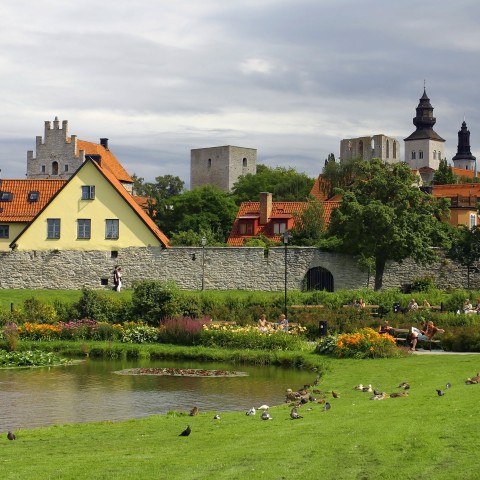
Did you know, for example, that Swedish is the key to having easier access to all Scandinavian languages? This is because Swedish, Danish, and Norwegian are mutually intelligible, which means speakers of one language have little trouble understanding speakers of the others.
If you’re a language-lover (or an admirer of all things Scandinavian), learning Swedish is the best way to start!
So, let’s look at the main reasons to learn Swedish and discuss how speaking a foreign language will bring amazing benefits to your life.
 Table of Contents
Table of Contents
- Benefits of Learning a Foreign Language
- Personal and Professional Benefits
- Is it Easy?
- The Fastest Way to Learn Swedish
1. Benefits of Learning a Foreign Language
In today’s world, it’s becoming more and more common to study a foreign language. Further, science is proving that doing so will not only impact your life on a personal and professional level, but it can also improve your health and general wellbeing.
In this light, let’s look at our first three reasons to learn Swedish (or any other foreign language, for that matter!).
Reason 1: It will open your mind.
Spending time studying an unfamiliar alphabet, practicing different sounds, and generally striving to master a foreign language like Swedish has proven to have a positive effect on the learner’s mind.
People who are bilingual are often more open-minded, creative, and approachable compared to those who only speak one language. This is because, by learning a new language, one not only picks up new skills and abilities, but also develops new tastes and sensibilities that will change the way they see and interact with the world.
Being able to speak more than one language will make you more aware of other cultures and customs as well as more open to understanding different lifestyles and ideas.
Basically, studying Swedish (or another language!) will make you a better version of yourself, and add new layers and nuances to your personality and the way you experience life. Sounds like a good personal investment, doesn’t it?
Reason 2: You’ll gain access to a whole new world.
Not many people realize that speaking another language not only allows one to communicate with a whole new portion of the world population, but it also opens up new content in all fields.
Knowing Swedish, you’ll be able to enjoy a whole new world of movies, books, recipes, and anything else that you’re interested in!
Diving into your hobbies in the language you’re learning is also a great way to practice and keep your motivation high for reaching your language learning goals.
Are you a literature-lover? Reading books in their original version will be priceless!
Do you love cooking and experimenting in the kitchen? Just head to a Swedish food blog and surprise your friends with a Scandinavian-inspired dinner…all while practicing and learning about the Swedish language and culture!
And the list is endless, so go on and explore all the new content that’s now available to you thanks to your new language skills!
Reason 3: It will improve your brain health.
As we mentioned above, learning a foreign language improves creativity and can make you more approachable and open-minded…but it doesn’t end there! Many studies are now showing that it also enhances problem-solving abilities and multitasking skills, and being multilingual can go as far as delaying the onset of diseases like Alzheimer’s and dementia by years.

If you want your brain to be healthy, just choose a foreign language you’d like to study and get on with it. It’s really that simple.
Bilingual people have proven to be more logical, perceptive, and aware of their surroundings, and science is now proving that thinking in more than one language may increase our number of neural pathways. This means that we’ll be able to process information better and more efficiently.
What are you still waiting for? Learning Swedish will actually improve your brain health and function!
2. Personal and Professional Benefits
If you’re looking for more concrete, short-term reasons to learn Swedish, don’t fret: There are many more coming. In fact, learning a foreign language like Swedish will give you great advantages after just a few months of studying… Here’s how!
Reason 4: Learning Swedish will give you more travel opportunities.
Of course, many people want to be able to communicate in Swedish to travel to…well, Sweden.
Sure, Swedes usually speak good English and you can get by visiting their country without knowing a word of Swedish. However, personal experience has taught me that being able to communicate with the locals in their native language is always better.

Not only will you be able to travel safely and without misunderstandings, but you’ll also delight in unique experiences and adventures that you would probably miss out on only knowing English. Trust me, if you’re planning to travel in or move to Sweden, knowing even just some words in the language will make your trip even more unforgettable.
Plus, remember that knowing Swedish will make it easier to travel around Scandinavia in general, and not just in Sweden!
Reason 5: It will come in handy for life and business.
Sweden is one of the world’s top-rated places to live. And with free healthcare, free (and great!) education for all ages, and high salaries, it’s no wonder why.
In the past few years, many expats have decided to call Stockholm home and have no regrets. It goes without saying that, if you’re thinking of joining their ranks, learning Swedish is a must.

If you’re not quite ready to move to Sweden just yet, but would like to start a business here (or anywhere in Northern Europe), it’s still important to be able to communicate with the local communities in their native language.
It will not only make things easier, but it will also show your drive and willingness to learn in order to make your business take off.
Reason 6: You’ll be better able to dive into the culture.
If you visit or live in Sweden, not speaking the language will always leave you feeling somehow left out.
Only by learning how to understand and speak Swedish will you really be able to dive into the culture and become part of the local community. Your life will literally change once you start learning Swedish, and for the better!
As they say, language is a window into culture. Speaking Swedish will certainly help you understand the people who speak it natively, their history, and their customs on a deeper level—knowledge that would not be accessible to you if you only spoke English!
Reason 7: It will help you be a bridge between cultures.
If, like many of us, you want to work towards creating a more connected and understanding world, being able to speak Swedish will allow you to use your skills as a bridge between cultures.
Nowadays, the world is in great need of people who can help others understand different ways of life and habits, and being bilingual is the perfect way to help fill that missing connection.
3. Is it Easy?
Actually, the answer is yes! You didn’t expect this, did you?
If you still aren’t sure why to learn Swedish, consider the fact that doing so will be a great investment of your time and your efforts will be rewarded quickly.
Reason 8: It’s easy to pick up.
If you’re a native English speaker (or a non-native speaker who knows the language quite well), you’re in luck. Swedish is quite an easy language to pick up for us Anglophones.
The two languages share a similar structure, grammar, and even a good percentage of vocabulary from the same roots. After all, both Swedish and English are Germanic languages, and so are Norwegian and Danish. Which brings up our next reason…
Reason 9: It will make learning other languages easier.
As we already mentioned, Swedish will open the doors to a much easier experience learning Norwegian and Danish. If you’re planning to learn any other Scandinavian languages, Swedish is a great place to start.
However, the benefits of studying Swedish don’t end there: The skills you learn when learning a foreign language can easily be applied to any other language, even if it’s a completely different one.
Reason 10: The internet and technology make it so easy.

Imagine deciding to learn Swedish even just 30 years ago. You would have to go look for a bookshop specialized in language learning and buy at least a few pounds worth of books.
Nowadays, things are different. The internet and technology have revolutionized how we study and practice foreign languages, and it’s now easier than ever to access all kinds of content, wherever you are in the world.
So, take advantage of the amazing times we live in and start learning Swedish today!
4. The Fastest Way to Learn Swedish
Speaking of high-quality and accessible language learning content, make sure you visit SwedishPod101.com if you’re studying Swedish.
Here, you’ll find audio and video lessons for all levels, incredibly useful vocabulary lists, and all kinds of resources to help you become fluent faster.
If your plan is to travel around Sweden, don’t miss our travel survival course, which will allow you to make the most of your trip and remain safe while abroad.
On the other hand, if you’re committed and want to become an advanced Swedish speaker—whether for professional or personal reasons—make the commitment and start studying and practicing with us every day for excellent resources and expert language learning tips and strategies.
Before you go, we would love to hear from you. How close are you to a decision about Swedish? Do you still have any questions or concerns? Let us know in the comments, and we’ll do our best to help you out!

Speak Like a Native: 30 Swedish Proverbs and Idioms

Proverbs are popular sayings that provide a little dose of wisdom, a truth that is sometimes so obvious it’s overlooked.
Can you think of a proverb in your native language that touched you in an important moment of your life?
Well, I can think of one: “There is no time like the present.” So let’s get to it!
Proverbs add versatility and color to our spoken language, so today we’ll introduce you to the thirty most common Swedish proverbs. Using any one of these at just the right moment is sure to impress native speakers!
If you really want your language skills to shine, knowing proverbs in the Swedish language is a great way to start. And of course, it will also help you better fit in with Swedes and gain a deeper understanding of their culture!
 Table of Contents
Table of Contents
- Funny Swedish Proverbs
- Swedish Proverbs About Life
- Practical Swedish Proverbs
- Swedish Proverbs Shared with English
- Conclusion
1. Funny Swedish Proverbs
As they say, “Laughter is the best medicine.” How true! So let’s start by having a look at some humorous Swedish proverbs and sayings that Swedes often use to express their wisdom (and their wit)… Surprise native speakers with these funny axioms!
1. Ingen ko på isen.
- Literal translation: There’s no cow on the ice.
A cow on the ice would definitely be something to worry about! This one doesn’t really have an English equivalent, but it’s simply a way of saying “Don’t worry.”
2. Sitta med skägget i brevlådan
- Literal translation: To sit with your beard in the letterbox
- English equivalent: To be caught with your hands in the cookie jar
Change “hands” to “beard,” and “cookie jar” to “letter box,” and there you have it. In either case, you’ve been caught doing something dishonest.
3. Det ligger en hund begraven.
- Literal translation: There’s a dog buried.
- English equivalent: Something smells fishy.
This one just means that there’s something fishy going on.
4. Att ana ugglor i mossen
- Literal translation: To suspect there are owls in the bog
- English equivalent: To smell a rat
This is another way to describe the sensation of knowing something’s wrong. Even fishier than a buried dog!

5. Finns det hjärterum så finns det stjärterum.
- Literal translation: If there’s room in the heart, there’s room for the arse.
Where there’s friendship, there’s always space for one more. You can also use it to mean, “Move over, I wanna fit on the sofa!”
6. Inte skottat ända fram
- Literal translation: Not shoveled all the way
- English equivalent: Not the sharpest tool in the shed
If you’re “not shoveled all the way,” it means you’re really not the smartest.

7. Göra en höna av en fjäder
- Literal translation: To make a chicken out of a feather
- English equivalent: To make a mountain out of a molehill
This idiom refers to the act of making something unimportant seem very important.
8. Köp inte grisen i säcken.
- Literal translation: Don’t buy the pig in the bag.
- English equivalent: To buy a pig in a poke
Don’t buy something without having inspected it first. This proverb is also a warning against rash decisions.
2. Swedish Proverbs About Life
You know those sayings that make you feel all fuzzy inside, and leave you with a lovely feeling of knowing what life’s all about? Well, Swedes have quite a few of those!
These Swedish proverbs about life will make your heart melt like an icicle in front of a fire.
9. Rädsla mindre, hoppas mer; Ät mindre, tugga mer; Gnälla mindre, andas mer; Prata mindre, säg mer, Älska mer, och alla goda ting kommer att bli din.
- Literal translation: “Fear less, hope more; eat less, chew more; whine less, breathe more; talk less, say more; love more; and all good things are yours.”
This one is pretty self-explanatory, if a bit long! Basically, it says that a great life boils down to relaxing, not worrying, and not being greedy.
10. Älska mig mest när jag förtjänar det minst för då behöver jag det bäst.
- Literal translation: “Love me when I least deserve it, because that’s when I really need it.”
Again, pretty clear, yet poetic. Use this phrase if you’re dating a Swede and they’ll be impressed!

11. De som önskar att sjunga hittar alltid en låt.
- Literal translation: Those who wish to sing, always find a song.
- English equivalent: To make one’s own luck
If you really want something, you’ll find a way to get it.
12. Ett liv utan kärlek är som ett år utan sommar.
- Literal translation: A life without love is like a year without summer.
I mean, imagine a year in Sweden with no summer. That’s how important love is in life. You can definitely see how much Swedes love their summers!
13. Oro ger små saker en stor skugga.
- Literal translation: Worry often gives a small thing a big shadow.
This is a beautiful way of saying, “Don’t worry.” Much more poetic than the cow on ice, if you ask me. 😉

14. Borta bra, men hemma bäst.
- Literal translation: Away is good, but home is best.
- English equivalent: Home sweet home.
This phrase is usually said after spending some time away from home.
15. Ibland kan man inte se skogen på grund av alla träd.
- Literal translation: Sometimes you cannot see the forest because of all the trees.
This is something along the lines of a certain Zen proverb: “When the sage points at the moon, the fool looks at the finger.” Look beyond, and see the bigger picture!

16. Delad glädje är dubbel glädje; delad sorg är halverad sorg.
- Literal translation: Shared joy is a double joy; shared sorrow is half a sorrow.
Always share with your loved ones, both in joy and in sorrow.
3. Practical Swedish Proverbs
There are sentimental truths about life, like the ones we just looked at. And then there are practical truths, like “a watched pot never boils” (I’ve tried, it’s a real thing!).
So let’s dive into some practical Swedish sayings that will make our lives easier!
17. Det bästa stället att hitta en hjälpande hand är i slutet av din egen arm.
- Literal translation: The best place to find a helping hand is at the end of your arm.
- English equivalent: God helps those who help themselves.
This has basically the same meaning as the English version. If you want a better life, just make it happen.
18. Dra inte alla över en kam.
- Literal translation: Don’t pull everybody over the same comb.
- English equivalent: Don’t judge a book by its cover.
This proverb just means that you shouldn’t generalize people.
19. Det finns inget dåligt väder, bara dåliga kläder.
- Literal translation: There is no bad weather, there are only bad clothes.
This one is widely used in the winter months, and for a reason! But if you think there’s something wrong with the Swedish winter, think again: you’re probably just wearing the wrong clothes.

20. Den enes bröd är den andres död.
- Literal translation: One man’s bread is another’s death.
One person’s fortune is another’s misfortune. This one is often said in a philosophical manner to describe a situation where one prospers from the misfortune of another.
21. Den som köper det han inte behöver stjäl från sig själv.
- Literal translation: He who buys what he does not need steals from himself.
This is a great anti-consumerist Swedish proverb. If you don’t need something, just don’t buy it!
22. När den blinde bär den lame går båda framåt.
- Literal translation: When the blind man carries the lame man, both go forward.
- English equivalent: Unity is strength.
It’s a weird way of saying it, but it basically promotes collaboration to overcome problems… The Blind Man and the Lame is actually a Greek fable!
23. Lycka ger aldrig; den lånar bara ut.
- Literal translation: Luck never gives; it only lends.
- English equivalent: Luck is loaned, not owned.
You may have a lucky strike, but rest assured it won’t last!
4. Swedish Proverbs Shared with English
Some proverbs are, let’s say…international! They appear in many different languages, probably as a result of early travelers sharing their wisdom with different people in different places.
Here are some Swedish proverbs that also exist in English (and in many other languages, too!).
24. Gräset är alltid grönare på andra sidan.
The grass is always greener on the other side.

25. Gråt inte över spilld mjölk.
Don’t cry over spilled milk.
26. Den som spar han har.
Savers, keepers.
27. Andra tider andra seder.
Other times, other customs.
28. Betala med samma mynt.
To pay back with the same coin.
29. Affär är affär.
Business is business.
30. Allting går igen.
What goes around comes around.
5. Conclusion
“All good things must come to an end…” But it’s not really the end, is it? There’s so much more to learn about the Swedish language!
As they say, “Practice makes perfect,” so continue practicing your Swedish language skills on SwedishPod101.com. Using all the features we offer (audio podcasts, videos with transcriptions, word lists, a dictionary, and more), you’ll pick up this beautiful and interesting language in no time.
And remember, if someone you know feels down one day, cheer them up with one of the humorous Swedish proverbs from this list and make them laugh… We already know what the best medicine is, right?
Which of these Swedish proverbs is your favorite, and why? Let us know in the comments!

A Fairytale City Escape: Visit Stockholm’s Top Destinations

Imagine a summer’s day spent strolling along waterfront promenades and harbors, surrounded by pencil-colored historical buildings and leafy parks…
But wait, you don’t need to imagine it. Just visit Stockholm!
The capital of Sweden is made up of fourteen islands, through which the freshwater Lake Mälaren flows out into the Baltic Sea. Sounds like an idyllic place, doesn’t it? And that’s not all: Outside of the city, the Stockholm Archipelago continues with over 30,000 more islands.
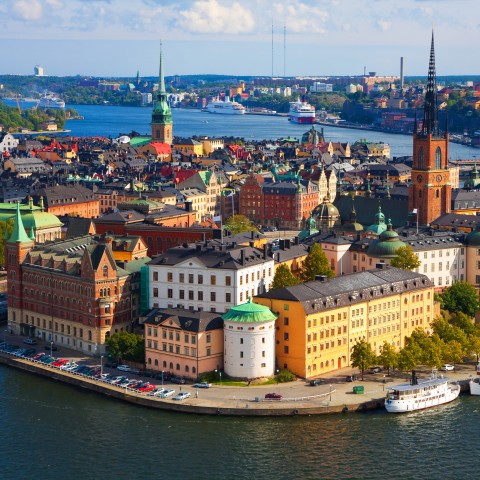
In this travel guide, you’ll discover Stockholm’s top eleven destinations as well as some extra tips and hints.
As St. Augustine said, “The world is a book and those who do not travel read only one page.” And I assure you, the pages of this wonderful and original city are definitely worth reading.
 Table of Contents
Table of Contents
- Before You Go
- Must-See Places for a 1-3 Day Trip
- Highly Recommended Places for a 4-7 Day Trip (or Longer)
- Swedish Survival Phrases for Travelers
- Conclusion
Before You Go
Have we given you enough reasons to visit Stockholm yet? Perfect. That means it’s time to organize your trip. Let us help you out with that!
When to Visit Stockholm
You’ve probably heard that winters in Sweden are tough. Lots of snow, freezing temperatures, only a few hours of light a day… Not ideal conditions for discovering the city!
Of course, tourists can be found all year round, but most people choose to visit Stockholm during the summer months of June through August. This is definitely the best time to visit Stockholm weather-wise, as you’ll be able to truly enjoy being outdoors (as do the Swedes) and take in all the city has to offer!
Visa
If you’re from Europe or North America, you’ll not need a visa to enter Sweden as a tourist; you’ll be allowed to stay for up to three months without problems. If you’re from somewhere else, you’ll need to check the requirements for entering Sweden.
Interesting Facts & Tips
- Sweden rejected the euro and continues to use Swedish krona as the national currency. (1 USD will get you SEK9.00.)
- Many places have a CARD ONLY policy, so be sure to have a working credit or debit card.
- Traveling by taxi can get quite expensive, so we recommend you make use of Sweden’s perfectly functioning public transportation system. Inside any metro station, you can buy daily and weekly passes as well as single tickets which include unlimited metro, tram, and bus journeys.
Must-See Places for a 1-3 Day Trip
Once you have all the basic info on how to be safe and organized on your trip, and have picked out your travel dates, you can start looking into the best places to see in Stockholm.
If you’re visiting Stockholm for the first time, it’s natural to feel overwhelmed with all the options. To give you a hand, we’ve outlined five places you can’t miss!
Gamla Stan
First on our list is Gamla Stan, the Old Town where you can take in the tranquil atmosphere of Stockholm.
This is one of the most well-preserved medieval city centers in Europe, and walking around it will feel like being in an open-air museum full of sights, attractions, restaurants, cafés, and shops.
In this pedestrian-friendly area paved with cobblestones, you’ll find both the oldest street in Stockholm (Köpmangatan) and the narrowest (Mårten Trotzigs Gränd).
Stortorget
This is the main square in the Old Town. Once you arrive here and have a look around, you’ll easily understand why these colorful facades are the most photographed in Sweden. Here’s where it all started for Stockholm, back in the thirteenth century.

Every stone and every corner here is filled with history. Our advice is to just sit on one of the benches and soak it all in.
If you visit around Christmastime, you’ll find a traditional market in the square.
The Stockholm subway
After you’ve explored the beautiful city center, we recommend you head to your next destination via the Stockholm tunnelbana, the city’s subway. If you have the time, you might even want to spend a while exploring it…we bet you won’t even feel the need to leave! This metro system is truly one of a kind.
The system comprises one hundred stations, each with unique art on its platform, walls, or waiting hall. The most beautiful ones include:
- T-Centralen
- Stadion
- Morby Centrum
- Kungstradgarden
- Solna Centrum
Stadshuset
The City Hall, which features the golden Three Crowns on its spire, is one of the most well-known silhouettes in Stockholm.
Made of eight million bricks and designed by architect Ragnar Östberg, this building houses offices and session halls for politicians and officials, as well as splendid rooms and unique works of art.
The great Nobel banquet is also held at City Hall, while Stockholm’s municipal council meets in Rådssalen, the Council Chamber.
Skinnarviksberget
If you want to step out of the bustle for an afternoon and enjoy wonderful views over the city and archipelago, head to the highest natural point in central Stockholm: Skinnarviksberget. The name literally means “the mountain bay of leather” because of its history of leather manufacturing and tanning.
Nowadays, of course, there’s no leather involved. Tourists and locals alike climb up here to enjoy a picnic with a view, or to marvel at the sunset over the city.
Highly Recommended Places for a 4-7 Day Trip (or Longer)
If you still have some time to spend in the beautiful capital of Sweden, there are a few more gems to visit around Stockholm!
Stockholm Archipelago
Just twenty minutes from the city starts a whole new world made up of over 30,000 small islands. It’s the Stockholm skärgård, the second-largest archipelago in the Baltic Sea.

The most popular way to see it is by ferry, with boats departing from central Stockholm multiple times a day. That said, you can also decide to boat, hike, sea kayak, bike, and swim in this wonderful setting! Whichever activity you pick, the experience of visiting the Stockholm archipelago will be unforgettable!
Skansen Museum
Skansen is an open-air museum that can be described as a “miniature Sweden.” Here, you’ll find farms and dwellings from all parts of the country that were disassembled and transported here.
If you’re curious about other parts of Sweden, but don’t have the time to visit the whole country, this is the perfect place to visit! It’s also a great family outing and is wonderfully located on Royal Djurgården, which offers spectacular views over Stockholm.
Fotografiska Museum
If you like photography at all, you can’t skip this. Fotografiska is one of the world’s largest collections of contemporary photography, and it periodically hosts four large exhibitions and up to twenty smaller ones.
On the top floor, you’ll find a café with one of the best views over Stockholm. Oh, and the restaurant serves fresh, seasonal dishes and focuses on sustainable gastronomy. What’s not to like about that?
Parks

If you spend a week or more in Stockholm, you’ll surely realize how green this city actually is.
You’ll find all kinds of parks, such as…
- …Millesgården, with sculptures created by artists Carl and Olga Milles.
- …Aspuddsparken, which offers entertainment for families and kids.
- …Kungsträdgården, the city’s oldest park featuring perfect lawns and tranquil cafés.
Djurgården is also a lovely park close to museums, galleries, and other attractions.
I bet you could spend an entire week visiting Stockholm and still not see all of the parks, so go and find your favorite!
Vasa Museum
The Vasamuseet brings you the exciting history of the Vasa ship. This 69-meter-long warship sank on its maiden voyage in the middle of the Archipelago in 1628 and was salvaged in 1961—a whopping 333 years later.

In the museum, you can see the only preserved seventeenth-century ship in the world (around 95% of which is original!). It’s been restored to its former glory and, through ten different exhibitions, you can get a glimpse of what life was like aboard the ship.
Stadsbiblioteket
Stockholm’s stadsbibliotek is the public library of Stockholm, designed by celebrated Swedish architect Gunnar Asplund. It’s one of the city’s most notable icons.
While you probably won’t stay long, it’s definitely worth visiting, even if only to take refuge on a windy morning. Step in and discover the real masterpiece—an incredible collection of books all around the cylindrical walls.
Swedish Survival Phrases for Travelers
Of course, most people in Sweden will understand and speak some English, but knowing some basic phrases in Swedish will be helpful (and it will certainly please the locals!).
Here are the phrases you might need:
- Hejsan. / Hello.
- Tack! / Thank you!
- Hejdå. / Goodbye.
- Förlåt. / Sorry.
- Mycket bra. / Very good.
- Jag förstår inte. / I don’t understand.
- Var ligger…? / Where is…?
- Hur mycket kostar…? / How much is …?
- Skulle jag kunna få…? / My I please have…?
- Hjälp! / Help!
Conclusion
So, have you decided to add some Swedish pages to your world travel book? If you’re planning to visit Stockholm and experience its fairytale atmosphere for yourself, take a look at SwedishPod101.com.
Here, with the help of highly qualified teachers, audio podcasts, word lists, and more, you’ll be able to finally start adding another language to your repertoire!
Start now, and you’ll realize that picking up a language is easier than you think. Not to mention it will make your experience in the country even more unforgettable!
Before you go: Which of these Stockholm travel destinations do you want to visit most, and why? Let us know in the comments!

English Words in Swedish: Do You Know Swenglish?

It’s no secret that Swedes speak English well.
But if you dropped in unexpectedly on a Swedish company’s conference call, you might be a little surprised to hear everyone speaking in English despite the fact that everyone working there was born and raised in-country.
What gives?
Shouldn’t they be speaking…Swedish?
Well, because of many different factors, there are quite a few modern colloquial English words in Swedish. They call this phenomenon “Swenglish,” and here’s what it’s all about.
 Table of Contents
Table of Contents
- Putting Swenglish in Context
- Examples of Swenglish
- English Loanwords
- What a Swedish Accent Sounds Like in English
- English Words Originally From Swedish
- Conclusion
Putting Swenglish in Context
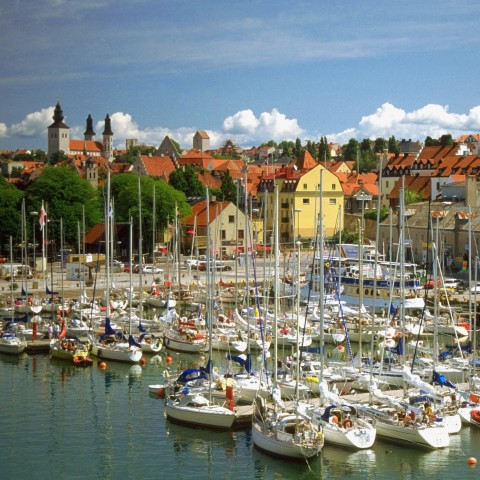
First off, this name isn’t really fair. It’s taken from the German equivalent “Denglish,” which refers to German laced with far too many English loans. However, “Swenglish” is actually used to describe English with Swedish characteristics, which we’ll get to in a little bit.
But how did all this English get into the Swedish language in the first place?
Well, the Vikings invaded England in the early Middle Ages. But that’s not the whole story, as many of them stayed there and ended up influencing the English language instead.
You see, Swedish is a Northern Germanic language while English is a Western Germanic one. This means that many centuries ago, around the fifth century BC, there was one parent language that later split up due to migration patterns and natural language change.
That makes it easy to pull words from one language to the other, kind of like baking cookies from the same mold and putting them on different trays.
In the nineteenth and twentieth centuries, English started becoming more and more of a world language, and Swedes began facing greater pressure to learn it. By the twenty-first century, they had achieved that goal in spades. The vast majority of Swedish youth these days gain full mastery of English while still in high school.
Because English is of such great international importance and considered trendy to learn, it’s the perfect language to pull words from, even among Swedes speaking Swedish to each other. Plus, recent immigration and English-taught higher education efforts both point to a rising use of English in Sweden.
But some Swedes are pushing back, saying that it’s unnecessarily eroding a perfectly good language and culture. However, this kind of popularity-driven language transition is quite tough to ignore, and sooner or later English words will have entered Swedish for good.
Examples of Swenglish

So what does this “Swenglish” or “Svengelska” look like in real life?
‘Swenglish’ refers to English words that mean something else in Swedish, having been adopted into the language and undergoing changes over time. After all, when non-native speakers start using a foreign word in their own language, it can easily take on a life of its own. To give you an idea of what we mean, let’s look at several Swenglish examples.
We’ll start with the word “athlete.” In English, it refers to anyone who practices a sport and uses their body to enter competitions. In Swedish, though, it typically refers to “a bodybuilder,” or someone who sculpts their muscles for aesthetic reasons. The “pure” Swedish word for “athlete” would be friidrottare.
Another example is the word sejfa, which sounds an awful lot like the English word “safe.” This one actually means “to play it safe,” or in other words, to be careful when attempting something new.
If you’ve studied any German, you may be familiar with the false friend tränar, which is also used in Swedish. It’s not “to train” as you would train a dog or cat, but “to exercise.”
Have you ever done any winter sports in Sweden? Better try to avoid peaken: the “peak of the season,” distinct from a mountain peak, which would be topp or spets.
Some words seem like they should be English words from their look and sound, and many Swedes might even swear to you that they are—but you won’t find them in an English dictionary.
Such words include legitimation (otherwise known as an ID card) and hangarounds (supporters of a political movement). Finally, if you hear a Swede complimenting your backslick, your first instinct might be to turn around and see if something’s gotten spilled on your shirt. But in reality, it just means “slicked-back hair.”
English Loanwords

Now that we’ve seen some examples of words that are slowly becoming native Swedish, we should mention that there are also plenty of words that are clearly English (for the time being, at least). Many of these English words used in Swedish are ones you’d hear in science, technology, and business meetings. This is because they’ve simply become the preferred way for experts in these fields to communicate.
Words like midquarter report, pressrelease, call center, and all time high are extremely commonplace in big Swedish business firms—remember, the official language of many Swedish businesses is English to begin with!
Note that the spacing or hyphenation of the examples above might be a little different from what English-speaking countries mandate as the norm. This is intentional, as these words have been adopted into Swedish orthographic conventions instead of maintaining the English ones.
Although Swedish verbs don’t conjugate for person or number, you can still see the Swedish verb suffix on loanwords like chillar (“to chill out”) or mailar (“to send by email”).
This is where the Swedish linguistic purists start tearing their hair out, by the way. They feel that Swedish speakers should make an effort to come up with their own native-Swedish equivalents, much like the Mandarin and Icelandic languages do.
If that were the case, you’d see loans like design replaced by formgivning and food processor replaced by matberedare. Only a serious and widespread effort to get rid of English loans could stop the process at this point, and that’s not very likely to get underway.
By the way, here is a quick fun fact before we move on to the next section: the word präst (“priest”) is actually a loanword from English, not a common Germanic word that happened to stay roughly recognizable. Scholars believe it comes from the Middle Ages and/or Renaissance!
What a Swedish Accent Sounds Like in English

Unfortunately, there’s one extremely famous rendition of a “Swedish accent” permanently entrenched in the minds of Americans—the character of the Swedish Chef from the children’s show Sesame Street.
While not really crossing any line into “offensive,” this has been the basis of quite a few good-natured jokes toward Swedes living abroad, to the extent that it should probably be laid to rest at this point.
The reason why that stereotype is so enduring, though, is because there really is a distinctive rhythm to Swedish speech. This is because the Swedish language, like Norwegian, Japanese, and a handful of other European and Asian languages, has a “pitch accent.”
You can find a few other good resources about Swedish pitch accent online, but the gist of it is that each word in Swedish has either a rising or falling pitch pattern. To native speakers, pronouncing a word with a different pattern sounds understandable but odd.
And turnabout is fair play: when Swedes speak English, they often subconsciously apply the pitch rules of their own language to English, leading to that musical rhythm.
Other than that, the long exposure many Swedes have to the English language means that they tend to pick up even subtleties of the pronunciation quite well. It helps that most of the sounds in English exist in Swedish, more so than for French or German speakers!
English Words Originally From Swedish
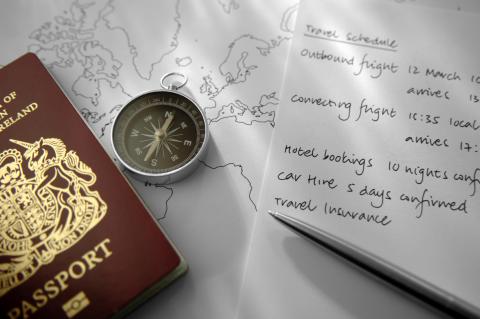
Since Swedish has never been that big of a language, its cultural reach has always been rather small. Still, when you look carefully at English vocabulary, you can find some rather common English words from Swedish or other Scandinavian languages.
The hobby of “orienteering” comes from the Swedish orientering, explaining why this word doesn’t quite sound like an English word even though it’s spelled like one.
Fartleks, a type of exercise training for long-distance runners, comes from the Swedish words fart (“speed”) and lek (“play”).
The metal tungsten is a combination of the Swedish words meaning “heavy” and “stone.”
Finally, the ubiquitous European moped comes from a blend of words from 1950s Swedish: motor och pedaler (“motor and pedals”).
Apart from those, many words that English speakers take for granted when discussing history and literature actually come from Old Norse, and so are Swedish by proxy if you will. These include elf, troll, and saga.
Conclusion
Even if Swedes end up using Swenglish and English in equal measure in the future, it doesn’t mean that there’s no hope for the Swedish culture as a whole.
People were probably saying the same thing when Anglo-Saxon speakers started using Norse terms on the British Isles! All languages shift and change with time, and Swedish is no exception.
Fortunately, you don’t have to get hired at a Swedish company to start picking up how the language is really used today. SwedishPod101 has got you covered.
Once you attain a strong level in Swedish thanks to our audio podcasts, videos with transcripts, word lists, and other useful resources, it’ll be easy for you to pick up and maintain a healthy balance of languages in your personal and professional Swedish lives.
Try out SwedishPod101 today and enjoy adding another language to your repertoire!
How many of these words were you surprised to find on our list? Are there any we missed? Let us know in the comments!

What Swedish Culture Really Means

How long was it after you heard the word “IKEA” that you started studying Swedish?
IKEA, like meatballs and beautiful nature, produces a strong image of Swedish culture and the Swedish people.
When you study a language, it’s important to know about the culture of where that language is spoken. If you learn from dictionaries and textbooks alone, you’ll never get a sense of what life is like on the streets in that country; if you only watch YouTube street interviews, you’ll never know what the literature is like.
How up-to-date or complete are your mental images of Sweden?
On this page, you’ll get to know Swedish culture a bit better. This knowledge, in turn, will act as an important complement to your language studies now and in the future.
 Table of Contents
Table of Contents
- Values and Beliefs
- Philosophies and Religions
- Family and Work
- Art
- Food
- Traditional Holidays
- Conclusion
1. Values and Beliefs

Unlike many other diverse or fractured cultures around the world, we can easily point to a “Swedish Culture” based on the general population’s values and beliefs alone—before diving into all the other things that make up what culture really is.
One of these Swedish culture characteristics is that Swedish people feel at home in a collectivist society.
This is reflected in political and economic discussion as the “Nordic Model,” describing the social structure and economic organization offered in Denmark, Norway, and Sweden. The state is expected to take care of its people, and it’s only able to do so if everybody in the society contributes.
Swedes feel at home with a government that provides generous social welfare benefits such as healthcare, for instance, because they feel that they’re all paying into it for the benefit of everyone in the country.
Finally, every Swede would tell you that they have a deep love of nature in their country. Cities are built with wide bike lanes and pedestrian paths so people can enjoy the world at a natural pace, and there’s always green space to be found. In the countryside, there’s actually a law guaranteeing everyone the right to camp and hike on all land, as long as it’s done in a responsible way with all waste and garbage picked up afterwards.
- → If you want to learn more about Swedish culture and society, visit our comprehensive lesson titled The Top 5 Things You Need to Know About Swedish Society!
2. Philosophies and Religions
Religion and mindset are two key elements of Swedish culture and traditions.
When it comes to religion, a glance at demographics will give you a very different picture than an interview on the street would, for instance.
On official censuses, the vast majority of Swedes are Lutheran Christian, that is, following Christian teachings but not paying close attention to the Pope. However, Swedes will tell you that this is pretty much in name only. Most Swedes rarely attend church services, with fewer than 20% of the population reporting that religion is important to them.
The big numbers come from the fact that until 1996, all newborn children in Sweden were automatically members of the Svenska kyrkan (Church of Sweden), which stopped being the state church in 2000. If your parents didn’t unregister you or you haven’t gotten around to it, you’re still counted as Lutheran in the books!
Since the 1960s, immigration into Sweden has also brought with it diverse religions, including several hundred thousand followers of Islam. Because of this, it’s more common to see mosques and halal restaurants from time to time in Sweden than it was previously.
There’s also one general philosophy in Sweden that most Swedes would say is the quintessence of Swedish culture, tying in with the points made in the last section. This is lagom, a word roughly translating to “moderation.” Swedes might describe lagom as:
- Inte för mycket, inte för lite. / “Not too much, not too little.”
This applies to physical moderation (such as with fast food and alcohol), but also to social moderation where individuals don’t want to be seen as overbearing or sticking out too much from the crowd.
3. Family and Work

The Swedish family, or familij, tends to be small. Usually, people don’t live with their extended family and instead live with both parents until they’re old enough to get a job and move from home. Many university students live independently in Sweden.
In Sweden, it’s considered normal to move out of your parents’ house as soon as you can, even if that means living by yourself in the same city where your parents live. Swedes enjoy their privacy! Stockholm, for instance, has a huge proportion of single-occupied apartments and this has contributed to a large housing crash.
There aren’t many “stay-at-home moms” in Sweden. Most families have two working parents, and this is made possible by generous family leave policies mandated by law for both father and mother to remain salaried while taking care of a new child.
Housework is divided equally among the family members, at least based on age. Everyone pitches in to cook and clean, and they take care of each other both inside the home and out.
When it comes to actual careers, Swedes work a little less than eight hours a day on average and take a little more than a month of vacation during the year, mostly during the summer. This is why it always seems like every hostel has a couple of Swedish tourists no matter where you are!
The Swedish workplace culture is rather conservative despite the emphasis on work-life balance. Men and women are expected to wear modest and formal clothing at the very least, though lately this has become more relaxed.
4. Art

Sweden has actually had a bit more success than its other Scandinavian neighbors in promoting a unique type of minimalist and utilitarian design for tools, furniture, and household appliances. This is the world-famous Scandinavian Design, brought to consumers around the world by the Swedish company IKEA.
As for music, the most well-known Swedish band of all time is most likely the 1980s pop group ABBA. Folk music enthusiasts will find plenty to like in Swedish traditional music as well, from Viking Age stuff all the way up to the folk revivals of the past century.
Finally, at the turn of the twenty-first century, there were short-lived yet well-loved Swedish electronic music crazes for the likes of Swedish House Mafia and Basshunter.
5. Food

Swedish culture and food go hand in hand. We actually have an article all about Swedish food coming out soon, so stay tuned for that!
The first thing most people think about is meatballs (köttbullar). When you started learning Swedish, that might have been one of your first words!
Beyond that, though, there’s a whole world of Swedish cooking waiting to be explored. A lot of it can be considered “rustic” cooking, as many beloved dishes come from simple home cooking from the countryside. Examples of this include fried cabbage, salted fish, and thick brown bread.
Swedes are also big fans of sweet food in general. This is quite evident when you take a look behind the counter glass at a Swedish café: you’ll see a huge array of pastries ripe for the taking, usually covered in some kind of glaze or powdered sugar. Princess cake might be the most famous Swedish pastry, but cinnamon buns also trace their roots back to Nordic cuisine.
And it only makes sense that Swedish cafés have such great snacks. The fika culture of lunch breaks at work extends outside of the working day. Fika is an activity beloved by every Swede, whether they’re working or not. In fact, saying it’s “beloved” might be framing it wrong—it’s simply treated as an inseparable part of the cultural fabric.
6. Traditional Holidays
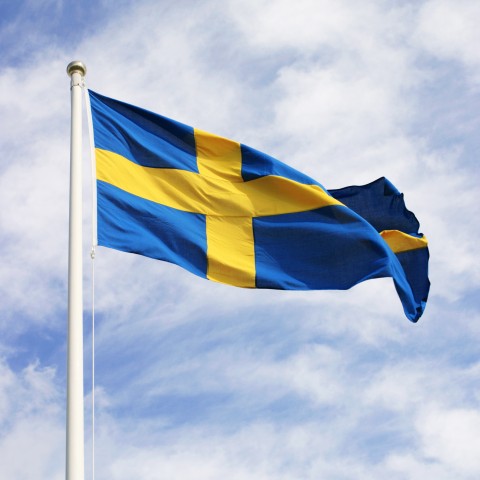
Few things are as central to the culture of Sweden than its holidays!
Sweden was never colonized by anybody, so you won’t find a “Swedish Independence Day” on the calendar. Instead, there’s Sveriges nationaldag (“National Day”), celebrated on June 6 every year. Interestingly enough, it commemorates the election of King Gustav Vasa from way back in 1523, but it wasn’t recognized as a holiday until the early twentieth century. On National Day, Swedes get together to wave flags, march in parades, and even visit the Stockholm Palace cost-free!
On May 1, Swedes celebrate International Workers’ Day, or May Day, with parades and a day off work.
Finally, jul (Christmas) is celebrated with Advent lights and decorated Christmas trees. In Sweden, Christmas is typically celebrated on December 24 instead of December 25, when it’s celebrated in many other countries. Families exchange gifts on Christmas Eve and then have Christmas Eve, Christmas Day, and annandag jul (“Boxing Day”) off to relax.
7. Conclusion
How much did you learn about Swedish culture and customs today? And more importantly, are you excited at the prospect of learning even more about Swedish culture? Let us know in the comments!
Try out SwedishPod101, the number-one online platform for learning the Swedish language. With cultural notes in practically every lesson, you’ll get both a language and cultural education at the same time in a seamless package. The Swedish language and culture really do complement one another, as you’ll naturally pick up both just from watching and listening to the language materials online.
Sign up today and bring your Swedish skills way past just the next level!

Walpurgis in Sweden: Ready to Have a Witchin’ Time?
Witches, sorcerers, costumes, tricks, and superstition…no, it’s not Halloween! We’re talking about Valborgsmässoafton (Valborg or Walpurgis Night) in Sweden.
While you might not associate the beginning of spring with witchcraft and sorcery, this correlation has some interesting roots in numerous European countries. In this article, you’ll learn about the origins of this mystical holiday and how it’s celebrated today.
Let’s go!

1. What is Walpurgis Night in Sweden?

In Sweden, Walpurgis and May Day take place each year on the night of April 30 and day of May 1 respectively. This festival is also common in a number of other European countries, including Germany, Finland, the Czech Republic, and Estonia.
Walpurgis Night is named after an eighth-century abbess named Saint Walpurgis (also known as Saint Walpurga). She was known for her effectiveness in spreading Christianity, as well as her supposed abilities to deflect witchcraft and heal a variety of ailments. People would invoke her in their prayers in the hope that she would keep the witches at bay.
You see, it was believed that witches and sorcerers would hold a Witches’ Sabbath each year on the night of April 30. They were thought to engage in crazy dances and conspire with demons—or even Satan himself—to harm Christians and cause other sorts of trouble.
In addition to invocations of Saint Walpurga, people would light bonfires on the hillsides and create as much noise as possible to scare away witches.
Over time, Walpurgis Day became less associated with actual witchcraft, and more and more people perceived this day as a time to reflect on the charms of such superstitions. Today, the holiday is mainly celebrated just for the fun of it, though the superstitions behind it are still strong in some places.
- → The warmer months are upon us, so why not see our vocabulary lists on the Top 15 Things to Do Over Spring Break and Summer Vacation?
2. Traditions and Celebrations for Walpurgis

Walpurgis and May Day celebrations in Sweden vary from region to region, but there’s a large focus on enjoying the spring and the coming of summer. In the morning, some Swedes indulge in a delightful breakfast of champagne and strawberries. Later in the day, people often gather with friends, family, and loved ones in local parks and indulge in BBQ and alcoholic beverages.
Walpurgis Day in Sweden is particularly popular among university students, who engage in activities such as the donning of the student cap in Gothenburg and rafting on Fyris River. Uppsala University is particularly lively during Valborg.
People of all ages enjoy participating in the bål (bonfire)! Due to the historical background of this holiday, lighting these large fires on which to brinna (burn) an effigy of a witch is a common activity. Some bonfire festivities will have various stalls set up that offer tasty foods and drinks. Music and dancing also play a large role in the holiday, especially around the bonfire.
Finally, though this is less common nowadays, there are often left-wing demonstrations that take place following Walpurgis night in Sweden.
3. Beltane
While the Valborg holiday likely originated from a pagan Norse holiday linked to the dead, there’s another holiday that seems to share roots with it: Beltane.
This is a pagan holiday still celebrated today in Wiccan and Neopagan circles, and it shares many of the same tenets as Valborg. In times past, there were four important festivals celebrated throughout the year, Beltane one of them. It marked the end of the winter and the beginning of summer, and bonfires were popular on this day.
The main purpose of Beltane was to protect cattle herds, crops, and dairy products from harm. This was done by appeasing the aos sí, a type of fairy or other supernatural race in Irish/Scottish mythology.
4. Vocabulary You Need to Know for Walpurgis in Sweden

Ready to impress your Swedish friends or hosts with some new vocabulary? Here are some of the words and phrases from this article, plus a few more!
- Vår / Spring
- Noun, common
- Eld / Fire
- Noun, common
- Valborgsmässoafton / Walpurgis Night
- Phrase, common
- Fyrverkeri / Firework
- Noun, neutral
- Fira / Celebrate
- Verb
- Bål / Bonfire
- Noun, neutral
- Brinna / Burn
- Verb
- Brasa / Campfire
- Noun, common
- Smällare / Firecracker
- Noun, common
- Ved / Firewood
- Noun, common
To hear and practice the pronunciation of each word and phrase, be sure to head over to our Walpurgis Night vocabulary list.
Final Thoughts
Valborg is a fascinating, whimsical holiday with some unclear origins, though its celebrations today are still popular in Sweden.
How do you celebrate the arrival of warmer weather in your country? Is there a special holiday involved? We look forward to hearing from you!
If you would like to continue learning about Swedish culture and the language, make sure you continue to explore SwedishPod101. Here are some fun pages to get you started:
- Summer Solstice Celebration: Midsummer Day in Sweden
- Essential Vocabulary for Life Events in Sweden
- Get Angry in Swedish with Phrases for Any Situation!
- Learn the Best Compliments in Swedish for Any Occasion
- 20 Swedish Quotes To Brighten Your Day
Happy learning!

The Best Swedish Foods For Your Study Breaks

Would you say that you’re the adventurous type? One for tall waves on high seas, long journeys, and tough challenges?
Whether you’re a beginner or an expert in Swedish, you know that the Swedish language can have its rough spots. Why not anchor yourself with something nice and tasty, something closely connected to Swedish culture?
Aside from language, cuisine is one of the most tangible aspects of culture. Go down any main street in any town and you’ll see restaurants serving local and foreign foods right alongside each other. But what about Swedish food?
You may be lucky enough to have Swedish restaurants nearby, or perhaps you have Swedish relatives who can cook nice meals for you.
None of the above? Well in that case, it looks like a trip to Sweden is in order. Start with the stomach, and the head will follow. In this article, you’ll learn about some of the tastiest Swedish food staples for Swedes both inside and outside of Sweden.
 Table of Contents
Table of Contents
- What is Swedish Food Like?
- Authentic Swedish Food vs. Overseas Swedish Food
- Unique Swedish Food
- Food-Related Vocabulary
- The Top Five Must-Try Dishes in Swedish Restaurants
- Conclusion
1. What is Swedish Food Like?
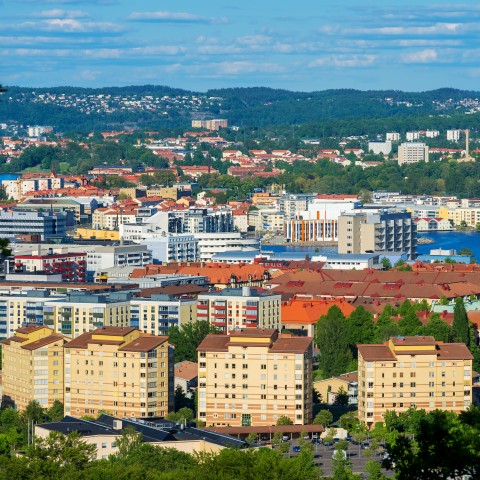
Unless you live in a very international city or a place with a large population of Swedish immigrants, you probably don’t have a particularly clear idea of Swedish cuisine. Aside from “meatballs,” most people would vaguely guess at fish and bread if they had to imagine what Swedes eat.
There’s some truth to that, but that’s far from the only staple food!
Traditional Swedish foods have a rustic flavor because of Sweden’s relatively poor recent history. A lot of people lived off of their own farms, and so they ended up cooking with preserved meat, bread, and vegetables. Cabbage, or kål, is a particularly common ingredient, as you’ll see in this article!
A lot of Swedish food can be described as quite hearty, with rich meats and sauces as well as desserts made with syrupy preserved fruits.
Later on, Sweden began attracting more immigrants. If you walk around a Swedish city today, you’ll see restaurants from places like the Middle East, India, and Asia.
Speaking of restaurants, cafe culture is very important in Sweden and there are lots of pastries and cakes to choose from. The concept of fika, or a coffee break, is one of the most “typically Swedish” things that most Swedes themselves can think of.
Many Swedes treat a fika as a natural break in the work day, as well as a way to meet up with friends or even go on dates. It’s not unheard of for a single fika to last more than an hour and a half on a weekend!
2. Authentic Swedish Food vs. Overseas Swedish Food
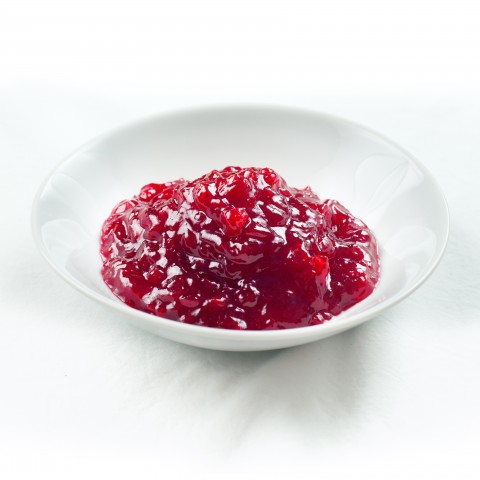
Many authentic Swedish cuisine dishes have made their way into other countries, but with regional twists.
Sweden’s most popular cultural export by far is the Swedish meatball, a mixture of ground beef and pork baked in a thick gravy for close to an hour before being served. However, in the U.S. at least, meatballs are more of a finger food served with cheese—no doubt due to Italian influence. In Sweden, they’re a main course served with mashed potatoes or with pasta.
The word gravlax (literally, “buried salmon”) might be somewhat familiar to people who enjoy cured salmon and bread. Indeed, it’s quite similar to smoked salmon on a bagel, a classic dish for New Yorkers. Gravlax, though, is not smoked; instead, it’s dry-cured through a mix of sugar, salt, and white pepper. Then instead of cream cheese, the typical topping is a light mustard sauce.
Why “buried,” then? Traditionally, the curing agents are mixed together in a jar with the salmon and it’s literally buried in the ground.
If you had to think of a berry associated with Sweden, you’d probably come up with the word lingonberry. It’s a small, red berry often made into jams and jellies in Scandinavia. In the United States, though, people tend to pair meat with cranberry sauce, not lingonberries. Lingonberries are a little bit smaller and a shade sweeter than cranberries, making them a bit more suitable for desserts.
And speaking of desserts, remember all the pastries in Swedish cafes? A classic one is smulpaj (“crumb pie”). Most pastries in English-speaking countries have a crust and a topping, but not smulpaj. This dessert has a topping of oats and flour and little else—it’s baked directly with the fruit filling on the baking dish.
3. Unique Swedish Food
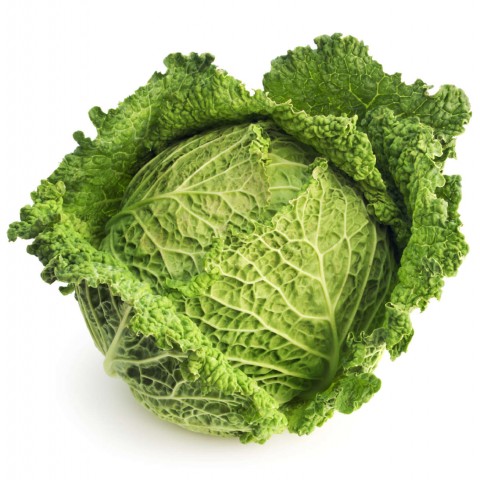
It’s tough to find foods other than the meatballs and lingonberry jam mentioned above when you’re outside of Sweden. In this section, we’ll introduce some typical Swedish dishes that rarely make it across the border.
First up is a sort of street snack known as tunnbrödsrulle. From the name, you can see that this has something to do with tunnbröd, or flatbread. Indeed, these are flatbread hot dogs! You take an ordinary sausage as bought from a street cart and lay it in a piece of flatbread before drizzling it with the topping of your choice.
The concept of eating fruit or roses in soup is a bit alien to some cultures. However, wild roses and their fruit grow all over Sweden. Therefore, nyponsoppa is a classic rosehip soup served as an appetizer or as a dessert.
Finally, brunkål (“fried cabbage”) is something that virtually every Swede had growing up at one point. Fast and easy to make, this is cabbage seasoned with meat or vegetable broth and vinegar before being rapidly stir-fried in a pan. It’s often eaten at Christmas to complement a Christmas ham.
4. Food-Related Vocabulary

Now it’s time to put down the dictionary and pick up a fork—let’s learn some Swedish phrases for the café or restaurant!
- Har ni någon lokal specialitet? / “Do you have a local specialty?”
- Har ni vegetarisk mat? / “Do you have vegetarian food?”
Perhaps you’re lucky enough to be invited for a fika, that luxurious time for coffee and pastries.
- En kopp kaffe, tack! / “A cup of coffee, please!”
When you’re satisfied with the meal, it’s good manners to pass on your compliments to the chef.
- Maten var utsökt! / “The food was delicious!”
Of course, that’s far from all the phrases you might need in a Swedish restaurant. Why not check out our vocabulary list of Swedish Words and Phrases for the Restaurant?
5. The Top Five Must-Try Dishes in Swedish Restaurants

To round it off, here are some of the most beloved dishes in the entire Swedish cooking lexicon.
A- Strömming
Herring is the small fish strongly associated with Scandinavia. There are actually two different types: the sill in the North Sea and the strömming caught in the Baltic Sea. Typically, Swedes pickle their herring in a sweet curing agent with plenty of salt and sugar. A couple of other popular Swedish herring recipes include nysekt strömming (fried and eaten in sandwiches) and a variety that’s served in sandwiches with senap (“mustard”).
B- Glögg
Even in the southernmost parts of Sweden, winter can get extremely cold. That’s a perfect time for a steaming cup of glögg, or Swedish mulled wine. Although other European countries have mulled wine traditions, in Sweden the glasses have raisins and almonds placed at the bottom. Additionally, the glasses are kept small as people tend to add vodka or cognac in the mix—giving the drink a bit of a kick!
C- Kåldolmar
One more appearance of cabbage here before the end. The word dolmar in the second half of the word actually comes from Turkish, similar to the English word dolmas. These cabbage rolls are stuffed with beef and pork before being baked in a thick broth in the oven. They’re super-rich and hearty, especially when served with a dash of lingonberry jam.
D- Kanelbulle
While they’re called ‘cinnamon rolls’ in English, the word bulle means “bun” in Swedish. This is probably Sweden’s most popular pastry—on average, each Swede consumes about six of them per week! The secret ingredient separating them from other cinnamon rolls (for those in the know) is cardamom, a spice from India.
E- Prinsesstårta
Legend has it that this delicate multi-layered cake was named in honor of Swedish princesses who adored baking and eating such a flavorful thing. It has three layers of cake separated by jam, custard, and cream, and the whole thing is topped with green marzipan. Lately, a few cakes with pink marzipan have made an appearance too.
6. Conclusion
Did this article whet your appetite? Hopefully not just for eating, but for learning as well. At SwedishPod101.com, you can get a whole lot more than just this sampler platter.
From our flagship podcast series to our YouTube videos and our longform articles, there’s something to suit any palate. The best part is, learning about interesting things like Swedish cooking actually helps you remember vocabulary! You’re going to see the word kanelbulle quite a few more times before your Swedish learning journey is over; you’re pretty much guaranteed to never forget its meaning.
Connecting a new word to something meaningful and emotional is absolutely the best way to learn a language. Sign up for an account at SwedishPod101.com and find out just how tasty the whole journey can be!

Swedish Waffle Day: A Sweet Start to Spring
What if I told you there was one day a year when you could eat all the waffles you could possibly want? Yes, I’m talking about Waffle Day (formerly known as Our Lady Day) in Sweden.
If you have a mighty sweet tooth on you (or just love pastries a lot), it’s your lucky day! We’ll discuss the origins of this holiday, get your mouth watering with some info on Swedish waffles, and cover some key vocabulary.
Let’s get started!

1. What is Waffle Day?

In Sweden, Våffeldagen (Waffle Day) is a springtime holiday during which the general population can indulge in a feast of waffles! But despite the holiday’s festive and indulgent nature, it was originally celebrated as a solemn feast called Vårfrudagen (Our Lady’s Day). A quick look at the two names is all you need to understand how a serious religious holiday came to be associated with this favorite Swedish pastry!
Our Lady’s Day is a holiday observed in numerous majority-Christian countries. It’s considered one of the most important dates on the Christian calendar, because it marks the supposed date on which the Angel Gabriel visited the Jungfru Maria (Virgin Mary) and told her she would give birth to Jesus Christ.
Nowadays, Swedish National Waffle Day is of a less religious nature and the focus is on making and consuming waffles!
- Even though this Swedish holiday has largely left its religious roots behind, you’ll still find it useful to learn some Religion vocabulary.
2. When is Waffle Day in Sweden?
Waffle Day takes place on March 25 every year, setting it apart from many other Catholic holidays, which are moveable. While this date is associated with Gabriel’s visit to Mary, its association with the springtime is also significant.
In the past, food was scarce during the winter months and people would have very few perishable items (such as eggs or milk) on hand. The arrival of spring meant the beginning of soil preparation for farms, and people once again had access to two of the most important ingredients in waffles. It was indeed a time for celebration. 😉
- Are you as ready for spring as we are? Then head over to our vocabulary list of the Top 15 Things To Do Over Spring Break!
3. Swedish Waffles… <3

For most of the population, Waffle Day in Sweden means just one thing: plate after plate of waffles! Typically, Swedish waffles are eaten with grädde (cream), sylt (jam), and sometimes even fresh fruit or berries. For this annual waffle festival, some restaurants will have special deals and many Swedish households will be filled with the aroma of waffles on the iron.
It’s interesting to note that waffles were not introduced to Sweden until the 1600s, and began as a savory dish rather than the sweet and decadent pastries we think of today. In the nineteenth century, Swedish waffles took on a distinctive shape and design with the introduction of the “Swedish waffle iron” which makes waffles with heart-shaped pieces. Prior to adopting this unique shape, they were square and cooked over a fire.
- Make sure to visit our Culture Class lesson on Sweets and Desserts for more information on the favorite sweet treats of Swedes!
4. Another Interesting Tradition…
In times past, there was another interesting tradition associated with Waffle Day. As we mentioned, this holiday takes place near the beginning of spring, when farmers begin their new crop season. To help the crops grow better, children were encouraged to run barefoot around the house or through a manure pile. This act was also thought to prevent the children’s feet from cracking during the hot summer months!
That doesn’t sound too pleasant, does it? I think I prefer the waffles…
5. Essential Swedish Vocabulary for Waffle Day

If learning about this holiday has made you drool, it’s a good sign that you should learn some waffle-related vocabulary! Let’s review some of the Swedish vocabulary words from this article, plus a few more.
- Smör (Butter) – noun, neutral
- Mjöl (Flour) – noun, neutral
- Våffeldagen (Waffle Day) – proper noun
- Jesus (Jesus) – proper noun
- Grädde (Cream) – noun, common
- Våffeljärn (Waffle iron) – noun, neutral
- Våffla (Waffle) – noun, common
- Jungfru Maria (Virgin Mary) – proper noun, common
- Vårfrudagen (Our Lady’s Day) – proper noun
- Sylt (Jam) – noun, common
Also make sure to check out our Waffle Day vocabulary list. Here, you can listen to the pronunciation of each word and practice along with the audio recording.
Final Thoughts
Who’s ready to bring out the waffle iron and get cooking? *raises hand*
Seriously though, we hope you enjoyed our lesson on this March 25 holiday and that you’re even more curious about Swedish culture after reading! If you would like to expand your knowledge even further, you can visit the following pages on SwedishPod101.com:
- Swedish Holidays
- SwedishPod101’s Essential Swedish Travel Phrase Guide
- Essential Vocabulary for Life Events in Swedish
- Get Angry in Swedish with Phrases for Any Situation!
- Learn the Best Compliments in Swedish for Any Occasion
If you like what we have to offer, please consider creating your free lifetime account today. Doing so will give you access to even more Swedish-language content and lessons!
Before you go: Do you prefer waffles or pancakes? (We won’t judge…) 😉













